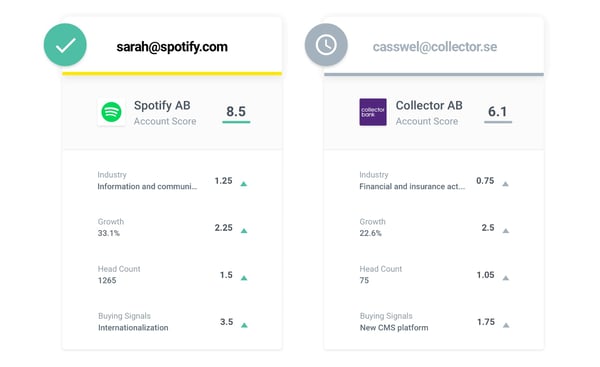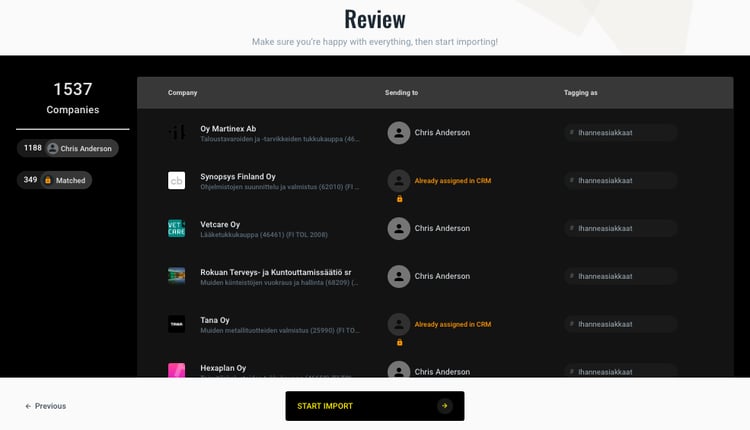4 Marketing Tactics To Increase Conversions With The Right Information
Data has become a commodity. For marketers, too. If that’s the case, how can marketing pros wear their data expert’s hat for five minutes and be better marketers? Read on and learn four ways marketers can increase conversions by using real-time company information.
1. Improve lead quality with better scoring models
What do you know about visitors? Are they ideal customers? Skilled inbound marketers will take quality over quantity any day of the week. But a high-quality lead is not a single data point—it’s not an email address or a phone number. Instead, true quality leads provide plenty of information on your prospects’ characteristics and their organizations.
Years ago, constructing such in-depth profiles without lengthy capture forms was a real head-scratcher for marketers. Today, it’s a simple, automated process that happens seconds after a lead comes in.

How does this work?
The process is straightforward. A sales intelligence platform will match the email domain (@myfabulousbusiness.com) to a company in its database and enrich the lead with all the key data points: company name, industry size, and key technologies used. Voila! There you have a proper lead profile.
💡 Takeaway: Improve the quality of your leads by enriching your marketing automation platform with fresh and reliable company data.
🧠 Deep dive: Lead Enrichment: How To Get The Most Out Of Your Inbound Leads
2. Create better customer segments for personalization at scale
In today’s business-to-business, buyers expect personalization when interacting with a company—an experience that mirrors consumer interactions. Such a high degree of personalization is not possible without smart data-driven target groups. Grouping and categorizing companies, according to their attributes, is what allows you to create many different segments. Data answers key questions that will guide your B2B segmentation, and subsequently, your messaging strategy.
How does this work?
With the right data points in your marketing automation database, you can label your accounts based on dozens of different attributes. For example, a software company is not just a software company, but it can be an eCommerce platform or a SaaS company.
Before launching a new campaign, narrow down your target audience using different filters based on those unique characteristics. Once you’ve created those segments, you can use them to create a different set of ads or targeted email campaigns.
💡 Takeaway: Data-driven insights directly influence which accounts receive what content and when, so the sales efforts are transformed into a time-based and need-based process.
📘 Deep dive: The Taxonomy Theory: The Art Of Classifying Your Accounts

3. Ensure sales and marketing work on the same data
So far, we’ve seen how technology and company information improve marketing processes. However, at the end of the day, a perfectly oiled data workflow is bound to fail if humans are out of sync. All the data points in the world are worth little if salespeople and marketing don’t work together to achieve common goals to increase revenue.
Ensure that sales and marketing have access to the same data. Company information lays the ground for sales and marketing collaboration by:
- Helping sales and marketing define a shared ideal customer profile. Based on that, What characterizes a high-quality marketing qualified lead?
- Understand the entirety of the sales funnel, having visibility on each other’s actions. This way, marketing can improve their lead nurturing activities, and sales can be more relevant in their outreach by tracking the right trigger events.
💡 Takeaway: Establish a service level agreement that defines the expectations that sales has for marketing with regards to lead quantity and lead quality and the expectations that marketing has for sales on how deeply and frequently sales reps will pursue each marketing qualified lead.
✍️ Free resource: Sales and Marketing SLA template
4. Sharpen your focus with account-based marketing
No other strategy ticks the boxes above like account-based marketing (ABM) does. Its laser-like focus aims to attract quality leads, boost sales and marketing collaboration, and allow bespoke content, messaging, and customer journeys for concrete segments.
The more you know about your prospects, the more efficiently you can implement an ABM strategy. The insights from real-time company information will help you build target lists for your ABM campaigns.
💡 Takeaway: ABM requires a solid sales and marketing tech stack, so take the time to choose your tools for account-based marketing. Jumping the gun and setting up the wrong tools can quickly leave you in ABM limbo.
📚 Learn more: The Definitive Guide to Account-Based Marketing
Now… are you ready?
Good… because Vainu has great new capabilities for marketing. Let’s have a chat?

